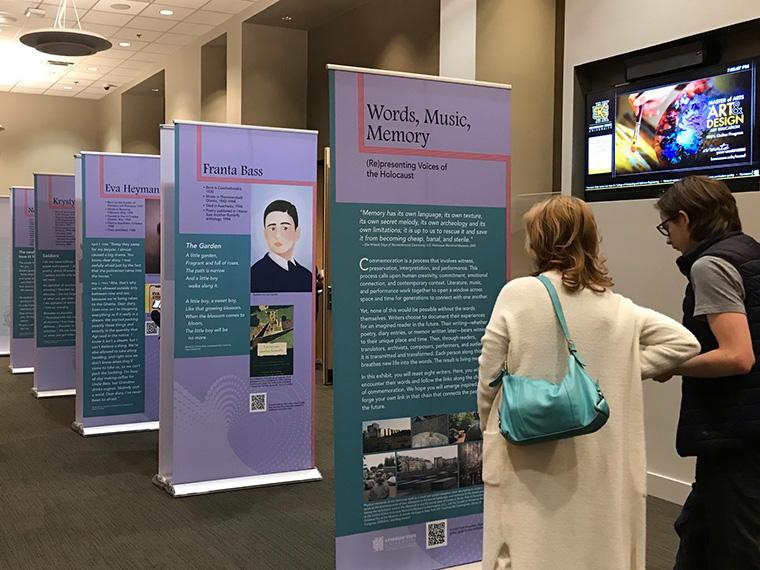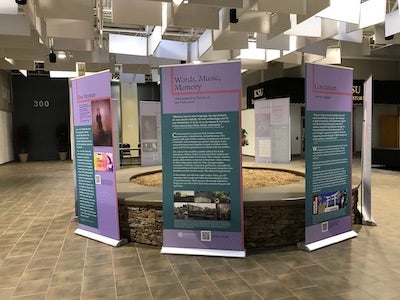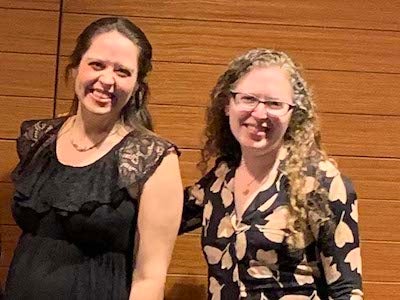Bearing Witness
Two alums collaborate on a powerful museum exhibition.
September 28, 2023
Kate Kaput

The Words, Music, Memory: (Re)presenting Voices of the Holocaust exhibition is on display from September 29-November 18.
Photo credit: Courtesy of Adina Langer
As a public historian, Adina Langer ’06 knows a thing or two about commemoration.
In the mid-2000s, she curated and produced content for the memorial exhibition at the 9/11 Memorial Museum. For the last eight years, she’s been the curator of Kennesaw State University’s Museum of History and Holocaust Education. Founded in 2006, the Georgia museum has produced more than 18 traveling exhibitions that visit schools, libraries, community centers, and houses of worship.
Langer says her time at Oberlin nurtured her intellectual curiosity. It also connected her with Sheena Ramirez ’06, a soprano who studied voice performance. In fact, the pair met when both were first-years living in Dascomb Hall.
 “Some of what we did at Oberlin collaboratively involved engaging deeply with poetry that Sheena would be performing as art songs,” Langer explains. “As a creative writing major, that was a love of mine, and it related to my concentration in poetry. We always enjoyed doing that and have kept it up over the years.”
“Some of what we did at Oberlin collaboratively involved engaging deeply with poetry that Sheena would be performing as art songs,” Langer explains. “As a creative writing major, that was a love of mine, and it related to my concentration in poetry. We always enjoyed doing that and have kept it up over the years.”
In 2020, Langer and Ramirez started working on a large-scale project that resulted in a museum exhibition, Words, Music, Memory: (Re)presenting Voices of the Holocaust, that will be on display at Oberlin starting September 29. The 10-panel traveling exhibition memorializes the poetry and diary excerpts of people who experienced the Holocaust—some who survived and others who perished—through music, composition, and performance.
"It highlights the idea of witness and then of translating that experience into art," Langer says. "It connects the past and the present, and it connects the people who are trying to interpret and understand the past to really bring it to life."
Words, Music, Memory features eight witnesses to the Holocaust whose written works are interpreted in varying ways. [see below, "The Exhibition's Voices"] Each panel showcases a different witness and explains how their words were preserved, archived, or translated and then ultimately adapted into some form of performance art, including music, film, and plays. A digital gallery guide that accompanies the exhibition delves deeper into the biography of each writer, plus interviews with the modern-day composers, lyricists, performers, and commissioners who interpreted their words.
“The goal is to highlight the entire commemorative process,” says Langer. “We wanted to show how you first engage with poetry, then select a piece of work to focus on, and then turn it into something that can then be accessed by an artist who wants to adapt it and perform it.”
Words, Music, Memory reflects the combined expertise of Langer and Ramirez. After Oberlin, Ramirez earned a master’s in music at the New England Conservatory of Music and a DMA in vocal performance, pedagogy, and literature from James Madison University. For the latter, she wrote her dissertation on four soprano song cycles based on Holocaust poetry, pairing this research with a lecture recital that accompanies Words, Music, Memory.
Langer says she “caught the research bug” during her sophomore year at Oberlin, when she and two friends took a road trip to Georgia. They stopped in Cades Cove, an abandoned town in Great Smoky Mountains National Park, where Langer became immediately fascinated by the history of the area. A year later, she returned to pore through scrapbooks, oral history transcripts, and other documents that both provided answers and served as the basis of her honors thesis on National Parks.
After earning a bachelor’s degree in history and creative writing, Langer earned a master’s in archives and public history at New York University. She is currently pursuing a PhD in public history from Georgia State University.
In spring 2023, Langer had the opportunity to work closely with students in professor Renee Romano’s Intro to Public Humanities course, a cornerstone of the Public Humanities integrative concentration. The students identified potential promotional avenues for the Words, Music, Memory exhibition at Oberlin, even creating a supplemental zine on the topic of memory.

“The students learned that so much of public humanities work is about making connections, building relationships, and trying to forge collaborations,” Romano says. “They saw what needs to be done to actually execute a project to go from A to Z.”
For Langer, though, this time wasn’t just about practicalities and marketing. Working with students gave her an opportunity to pass on knowledge and experience in the same ways alumni once did for her.
"As a student, I remember how powerful it was to have conversations with people who had been in my shoes only a few years before. I could see these students making connections about what it means to be out in the world, carrying forward your intellectual passions and interests."
After its time at Oberlin, Words, Music, Memory will be on display at Wake Forest University’s Lam Museum of Anthropology starting in December, followed by Elon University in March 2024. However, Langer and Ramirez say they feel particularly honored to bring their shared project to their alma mater, where both their friendship and their career paths began.
“This is something we’ve been doing for more than 20 years, where I’ve been coming to Adina and saying, ‘Let’s talk about poetry and how music enhances it,” Ramirez says. “This project looks at how music and other forms of commemoration can honor the words of people who have experienced the darkest chapters of our history.”
Words, Music, Memory: (Re)presenting Voices of the Holocaust opens September 29 in the first floor gallery of the Mary Church Terrell Main Library, and is open daily through Saturday, November 18. The exhibition culminates with a lecture performance on November 16, featuring soprano Sheena Ramirez, oboist Courtney Miller, and pianist Daniel Michalak. Curator Adina Langer will provide commentary during the performance and discuss Holocaust commemoration and curating traumatic histories. Langer will also be in conversation with Professor Renee Romano on November 16.
The Exhibition's Voices
The individuals whose words are featured in Words, Music, Memory were carefully selected to represent a diversity of Jewish witnesses to the Holocaust, including (but not limited to) recognizable voices like Anne Frank and Elie Wiesel.
“We really wanted to bring both lesser-known and very well-known people into this space,” says Langer. “The exhibit is presented from younger to older and from those who perished to those who survived.”
- Franta Bass wrote poems in the Theresienstadt Ghetto before dying at Auschwitz at age 14. His poems were included in the Czech children’s anthology I Never Saw Another Butterfly, which inspired commemorative works by composers and playwrights alike.
- Selma Meerbaum-Eisinger was a teenager who died at Michailowka labor camp, though her boyfriend managed to keep her poetry notebook throughout his own incarceration. Her poetry inspired a soprano song cycle titled “In Sleep, the World Is Yours" by composer Lori Laitman.
- Anne Frank, a German-Jewish teenager who died at Bergen-Belsen, became posthumously famous after the publication of her diary. Her story has been adapted many times, as in the play The Diary of Anne Frank and the 1995 Japanese animated film Anne No Nikki, both featured in the exhibition.
- Éva Heyman died in Auschwitz at age 13, but her mother published her Diary of Éva Heyman in 1947. In 2018, the Instagram account @Eva.Stories won a prestigious Webby Award for its poignant presentation of the late teen’s words.
- Krystyna Żywulska was a Polish-Jewish political prisoner who penned the memoir I Survived Auschwitz, which, along with openly gay German-Jewish survivor Gad Beck’s memoir, inspired two short operas.
- Shmerke Kaczerginski was a radical activist and Yiddish poet whose “Yid Du Partizaner” was turned into a sonata for cello and piano, composed by Laurence Sherr.
- Nelly Sachs, a poet who escaped Berlin for Sweden, was awarded the Nobel Prize for Literature. Many of her poems have been turned into choral and instrumental arrangements.
- Elie Wiesel, who spent time in both Auschwitz and the labor camp Buna, became a renowned speaker and writer on the topic of memory. His memoir Night is the basis of performances featuring the music of composer Leib Glantz.
You may also like…
Josh Nolan Named Vice President, General Counsel, and Secretary at Oberlin
Distinguished attorney brings extensive experience in higher education law.
Learning by Teaching: Oberlin Students Share Global Music with Young Learners
College and Conservatory students in PACE 103 prepare local children for an immersive community concert at Oberlin.
Nuiko Wadden ’02 Joins Oberlin Conservatory Faculty as Assistant Professor of Harp
The versatile musician brings extensive opera, orchestral, and contemporary music experience to her role


